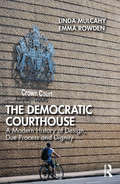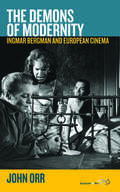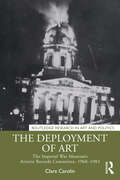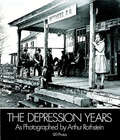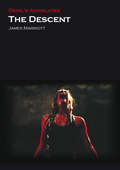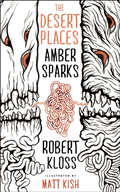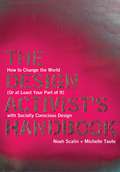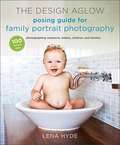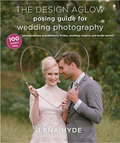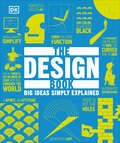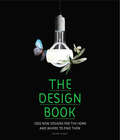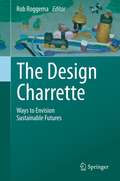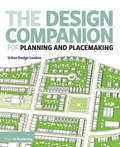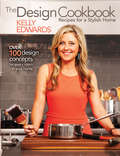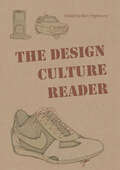- Table View
- List View
The Democratic Courthouse: A Modern History of Design, Due Process and Dignity
by Linda Mulcahy Emma RowdenThe Democratic Courthouse examines how changing understandings of the relationship between government and the governed came to be reflected in the buildings designed to house the modern legal system from the 1970s to the present day in England and Wales. The book explores the extent to which egalitarian ideals and the pursuit of new social and economic rights altered existing hierarchies and expectations about how people should interact with each other in the courthouse. Drawing on extensive public and private archives kept by the Ministry of Justice, but also using case studies from other jurisdictions, the book details how civil servants, judges, lawyers, architects, engineers and security experts have talked about courthouses and the people that populate them. In doing so, it uncovers a changing history of ideas about how the competing goals of transparency, majesty, participation, security, fairness and authority have been achieved, and the extent to which aspirations towards equality and participation have been realized in physical form. As this book demonstrates, the power of architecture to frame attitudes and expectations of the justice system is much more than an aesthetic or theoretical nicety. Legal subjects live in a world in which the configuration of space, the cues provided about behaviour by the built form and the way in which justice is symbolised play a crucial, but largely unacknowledged, role in creating meaning and constituting legal identities and rights to participate in the civic sphere. Key to understanding the modern day courthouse, this book will be of interest to legal scholars and students in all fields of law, sociology, political science, psychology and criminology.
The Demons of Modernity: Ingmar Bergman and European Cinema
by John OrrIngmar Bergman's films had a very broad and rich relationship with the rest of European cinema, contrary to the myth that Bergman was a peripheral figure, culturally and aesthetically isolated from the rest of Europe. This book contends that he should be put at the very center of European film history by chronologically comparing Bergman's relationship to key European directors such as Carl Theodor Dreyer, Jean-Luc Godard, Michelangelo Antonioni, and Andrei Tarkovsky, and also looks at Bergman's critical relationship to key movements in film history such as the French New Wave. In so doing, it demonstrates how Ingmar Bergman's films illustrate the demonic struggle in modernity between faith and secularity through "his intense preoccupation with the malaise of intimacy."
The Deployment of Art: The Imperial War Museum’s Artistic Records Committee, 1968–1982 (Routledge Research in Art and Politics)
by Clare CarolinThis book explores the Artistic Records Committee (ARC) of the Imperial War Museum (IWM) as a bureaucratic mechanism that enabled the deployment of art as an instrument of war.The ARC was established in 1972 to commission artistic records of activities involving the British Armed Forces (BAF) deployed in the North of Ireland as part of Operation Banner. Through a close reading of artworks, archival research, and interviews with artists, former IWM staff, and a former British Army psychological operations (PSYOPs) expert, this book shows that the ARC was implicated in the ‘propaganda war’ that the British Government waged to counteract negative public perceptions of British military presence and activity in the North of Ireland after ‘Bloody Sunday,’ and later during Britain’s 1982 campaign to recapture the Falklands/Malvinas from Argentina (Operation Corporate). The two case studies are painter Ken Howard’s ARC commissions to record Operation Banner in 1973 and 1978 and illustrator Linda Kitson’s ARC commission to record the ‘Falklands Campaign’ in 1982. At a time when emergent conceptual and non-object-based art practices were increasingly concerned with exposure, concealment, and photographic evidence, the book demonstrates the potential operational significance of creating pictorial records and utilising art as a tool of warfare.This volume will be of interest to researchers and scholars of art history, museum studies, art and politics, and military and intelligence studies, as well as those studying the recent history of the North of Ireland and the Falklands/Malvinas war.
The Depression Years as Photographed by Arthur Rothstein
by Arthur RothsteinOutstanding 1930s photos: famous dust storm photo, ragged children, the unemployed, much more. 120 photographs. Captions.
The Descent
by James MarriottThe story of an all-female caving expedition gone horribly wrong, The Descent (2005) is arguably the best of the mid-2000s horror entries to return verve and intensity to the genre. Unlike its peers (Saw [2004], Hostel [2011], etc.), The Descent was both commercially and critically popular, providing a genuine version of what other films could only produce as pastiche. For Mark Kermode, writing in the Observer, it was "one of the best British horror films of recent years," and Derek Elley in Variety described it as "an object lesson in making a tightly-budgeted, no-star horror pic." Time Out's critic praised "this fiercely entertaining British horror movie;" while Rolling Stone's Peter Travers warned prospective viewers to "prepare to be scared senseless." Emphasizing female characters and camaraderie, The Descent is an ideal springboard for discussing underexplored horror themes: the genre's engagement with the lure of the archaic; the idea of birth as the foundational human trauma and its implications for horror film criticism; and the use of provisional worldviews, or "rubber realities," in horror.
The Descent
by James MarriottThe story of an all-female caving expedition gone horribly wrong, The Descent (2005) is arguably the best of the mid-2000s horror entries to return verve and intensity to the genre. Unlike its peers (Saw [2004], Hostel [2011], etc.), The Descent was both commercially and critically popular, providing a genuine version of what other films could only produce as pastiche. For Mark Kermode, writing in the Observer, it was "one of the best British horror films of recent years," and Derek Elley in Variety described it as "an object lesson in making a tightly-budgeted, no-star horror pic." Time Out's critic praised "this fiercely entertaining British horror movie;" while Rolling Stone's Peter Travers warned prospective viewers to "prepare to be scared senseless." Emphasizing female characters and camaraderie, The Descent is an ideal springboard for discussing underexplored horror themes: the genre's engagement with the lure of the archaic; the idea of birth as the foundational human trauma and its implications for horror film criticism; and the use of provisional worldviews, or "rubber realities," in horror.
The Descent (Devil's Advocates)
by James MarriottThe story of an all-female caving expedition gone horribly wrong, The Descent (2005) is arguably the best of the mid-2000s horror entries to return verve and intensity to the genre. Unlike its peers (Saw [2004], Hostel [2011], etc.), The Descent was both commercially and critically popular, providing a genuine version of what other films could only produce as pastiche. For Mark Kermode, writing in the Observer, it was "one of the best British horror films of recent years," and Derek Elley in Variety described it as "an object lesson in making a tightly-budgeted, no-star horror pic." Time Out's critic praised "this fiercely entertaining British horror movie;" while Rolling Stone's Peter Travers warned prospective viewers to "prepare to be scared senseless." Emphasizing female characters and camaraderie, The Descent is an ideal springboard for discussing underexplored horror themes: the genre's engagement with the lure of the archaic; the idea of birth as the foundational human trauma and its implications for horror film criticism; and the use of provisional worldviews, or "rubber realities," in horror.
The Desert Places
by Matt Kish Amber Sparks Robert KlossThe Desert Places is a pocket-sized edition of a hybrid text by Amber Sparks and Robert Kloss that explores the evolution of evil in worlds both seen and unseen and features full-color illustrations by Matt Kish, illustrator of the critically acclaimed Moby-Dick in Pictures: One Drawing for Every Page.
The Design Activist's Handbook
by Michelle Taute Noah ScalinWe Want You! Will you join the ranks of design activists? Doing good is too important to think of as work better left to those fictitious "other" designers. People more famous. More talented. More connected. Richer. Younger. Braver. (Insert your own mental roadblock here.) In truth, anyone can be a design activist. It just starts with a commitment to yourself and your values. A commitment to making conscious choices and realizing how all the decisions you make as a graphic designer affect other people and the planet. It's about being awake instead of sliding by with the way things always have been done. This book is for every graphic designer who's ever sat at a computer, thinking: Is this it? Isn't there more? It's a tool to help you figure out how to start making a difference and making a living at the same time--no matter where you live and work right now. Just open this book and we'll help you start walking in the right direction. It doesn't have to be perfect. Little actions from a lot of people add up to big change. This isn't a contest about who's the greenest or the most radical. It's a movement, and we're inviting you to join right now.
The Design Activist's Handbook: How to Change the World (Or at Least Your Part of It) with Socially Conscious Design
by Noah ScalinWe Want You!Will you join the ranks of design activists?Doing good is too important to think of as work better left to those fictitious "other" designers. People more famous. More talented. More connected. Richer. Younger. Braver. (Insert your own mental roadblock here.) In truth, anyone can be a design activist.It just starts with a commitment to yourself and your values. A commitment to making conscious choices and realizing how all the decisions you make as a graphic designer affect other people and the planet. It's about being awake instead of sliding by with the way things always have been done.This book is for every graphic designer who's ever sat at a computer, thinking: Is this it? Isn't there more? It's a tool to help you figure out how to start making a difference and making a living at the same time--no matter where you live and work right now.Just open this book and we'll help you start walking in the right direction. It doesn't have to be perfect. Little actions from a lot of people add up to big change. This isn't a contest about who's the greenest or the most radical. It's a movement, and we're inviting you to join right now.
The Design Activist's Handbook: How to Change the World (or At Least Your Part of It) with Socially Conscious Design
by Michelle Taute Noah ScalinWe Want You! Will you join the ranks of design activists? Doing good is too important to think of as work better left to those fictitious "other" designers. People more famous. More talented. More connected. Richer. Younger. Braver. (Insert your own mental roadblock here.) In truth, anyone can be a design activist. It just starts with a commitment to yourself and your values. A commitment to making conscious choices and realizing how all the decisions you make as a graphic designer affect other people and the planet. It's about being awake instead of sliding by with the way things always have been done. This book is for every graphic designer who's ever sat at a computer, thinking: Is this it? Isn't there more? It's a tool to help you figure out how to start making a difference and making a living at the same time--no matter where you live and work right now. Just open this book and we'll help you start walking in the right direction. It doesn't have to be perfect. Little actions from a lot of people add up to big change. This isn't a contest about who's the greenest or the most radical. It's a movement, and we're inviting you to join right now.
The Design Aglow Posing Guide for Family Portrait Photography: 100 Modern Ideas for Photographing Newborns, Babies, Children, and Families
by Lena HydeGet inspired to take family portraits your clients will love Whether you're facing your first family portrait shoot or are a seasoned professional looking for fresh inspiration, Design Aglow's 100 ideas for posing newborns, babies, children, siblings, and families will help you approach each session brimming with confidence and creative ideas. Design Aglow's style-savvy approach has resonated with photographers (and their clients) everywhere. This curated collection reflects their modern sensibility, with poses from industry superstars such as Elizabeth Messina, Rachel Devine, Jose Villa, Tara Whitney, and Anna Kuperberg. You'll also get tips on directing your subjects, follow-up shots for each setup, and behind-the-scenes lighting information. Both eye candy and practical reference tool, The Design Aglow Posing Guide for Family Portrait Photography will inspire any family photographer, novice or expert, to "wake up" their style and take beautiful portraits for modern families.
The Design Aglow Posing Guide for Wedding Photography
by Lena HydeRefresh your toolbox with modern poses your clients will love Whether you're shooting your first wedding or are a seasoned professional, the formal portrait session can be one of the toughest parts of photographing a wedding. Faced with tight timelines, unpredictable lighting, and clients eager for stylish, flattering portraits, it's critical to come prepared with a toolbox of fresh, modern poses. Happily, Design Aglow's 100 ideas for posing engaged couples, brides, brides and grooms, and bridal parties will help you approach each session brimming with confidence and creative ideas.Design Aglow's style-savvy approach has resonated with photographers (and their clients) everywhere. This curated collection reflects their modern sensibility, with poses from industry superstars such as KT Merry, bobbi+mike, Elizabeth Messina, Jessica Lorren, Milou + Olin, Paul Johnson, Lisa Lefkowitz, Anna Kuperberg, and more. You'll also get tips on directing your subjects, easy follow-up shots for each setup, and behind-the-scenes lighting information. Both eye candy and practical reference tool, The Design Aglow Posing Guide for Wedding Photography will inspire novices and experts alike to "wake up" their style and take beautiful portraits today's brides and grooms will love.
The Design Book (DK Big Ideas)
by DKDiscover the key ideas, innovations, and breakthroughs in the history of design.The perfect introduction to the subject, this book explores and explains the big ideas and key principles behind more than 90 of the world's most celebrated design concepts and movements, placing each in their historical, cultural, and stylistic context.The Design Book analyzes the ideas and principles behind history's most pioneering designs, exploring how creativity and innovation shape our lives. Tracing the evolution of design from its roots in early manufacturing to the cutting-edge concepts of the 21st-century, entries profile the individuals and manufacturers behind each groundbreaking development, and explore their influences and inspirations.Illustrating how and why different styles emerged and became popular, the book provides a fascinating insight into design movements, showing how each one began and describing its philosophy and visual style, from the Aesthetic Movement to Mid-Century Modern and Contemporary.Using the Big Ideas series' trademark combination of clear explanation, witty infographics, and inspirational quotes, The Design Book explains what makes a truly great design and reveals the hidden stories behind the designed world.
The Design Book: 1000 New Designs For The Home And Where To Find Them
by Jennifer HudsonThe Design Book brings together the best in contemporary design for the home, presenting a huge range of striking new products: tables and chairs, sofas and beds, storage, kitchens and bathrooms, tableware, textiles and surfaces, lighting, electronics and more. Works by the finest international talents, including Shin and Tomoko Azumi, Sebastian Bergne, Ronan and Erwan Bouroullec, Fernando and Humberto Campana, Piet Hein Eek, Jaime Hayon, Thomas Heatherwick, Javier Mariscal and Patricia Urquiola, are featured. In-depth interviews with twelve key designers explore pivotal projects and approaches to design.Web addresses of designers and manufacturers are given for every object, along with full captions and colour illustrations, making every design easy to source.
The Design Book: 1000 New Designs For The Home and Where to Find Them
by Jennifer HudsonThe Design Book brings together the best in contemporary design for the home, presenting a huge range of striking new products: tables and chairs, sofas and beds, storage, kitchens and bathrooms, tableware, textiles and surfaces, lighting, electronics and more. Works by the finest international talents, including Shin and Tomoko Azumi, Sebastian Bergne, Ronan and Erwan Bouroullec, Fernando and Humberto Campana, Piet Hein Eek, Jaime Hayon, Thomas Heatherwick, Javier Mariscal and Patricia Urquiola, are featured. In-depth interviews with twelve key designers explore pivotal projects and approaches to design.Web addresses of designers and manufacturers are given for every object, along with full captions and colour illustrations, making every design easy to source.
The Design Charrette
by Rob RoggemaThis book was written to support community involvement in the design process, to help prevent negative outcomes that can result from a top-down design approach. The combination of community involvement and design is, at least in literature, not very extensive. Although much has been written about stakeholder involvement, this is often not directly related to design processes, which - most importantly - deprives community members of the opportunity to design their desired future themselves. The Design Charrette: Ways to Envision Sustainable Futures provides a theoretical foundation establishing the benefits of organizing a design charrette for community-based planning, supported by many practical examples. The book includes sections on collaborative learning, practical guidance, theory and case studies in many different contexts: long and short charrettes, urban and rural subjects, and Dutch, Chinese, Australian, Indian and European examples. Part I: General Theory offers a detailed overview of the charrette process, a chapter on innovations in organizational and community learning and a chapter on shifting paradigms in the design charrette. Part II presents a number of case studies, including the INternational Conference on Renewable Energy Approaches for the Spatial Environment (INCREASE); charrettes accomplished in two days in the communities of Sea Lake and Bendigo in Australia; a chapter on lessons for the future, describing rural participatory design in Rajasthan, India; a description of learning by practice in a high-pressure student atelier; a chapter entitled Design Charrettes for Sustainable Building in China and more. The Design Charrette challenges the conventional wisdom that good design by itself will bring about the benefits the designer envisions. By demonstrating and analyzing the effectiveness of design charrettes in personal development and learning, and as a way to share desired future pathways, the book benefits everyone who may be leading, considering or participating in a design charrette.
The Design Collection Revealed: Adobe InDesign CS4, Photoshop CS4 & Illustrator CS4
by Elizabeth Eisner Reding Chris BotelloNIMAC-sourced textbook
The Design Collection Revealed: Adobe InDesign CS5, Photoshop CS5 & Illustrator CS5
by Elizabeth Eisner Reding Chris BotelloTHE DESIGN COLLECTION REVEALED provides comprehensive step-by-step instruction and in-depth explanation for three of today's most widely used design and layout programs: Adobe InDesign CS5, Adobe Photoshop CS5, and Adobe Illustrator CS5. Readers gain practical experience with the software as they work through end-of-chapter learning projects and step-by-step tutorials. An integration chapter demonstrates how to move from one application to the other. Full-color illustrations and a user-friendly design combine to create a robust learning experience that reveals how to master the latest features of Adobe's popular design suite.
The Design Companion for Planning and Placemaking
by TfL and UDLThis book is an essential primer to help those involved in planning secure higher standards of building, open space and neighbourhood design and the delivery of better places. The UK Government’s policy for design in the planning system is contained in the National Planning Policy Framework (NPPF), with expanded guidance being provided in the Planning Practice Guidance (PPG). This book expands on these and provides up to date explanations, examples, top tips and practical advice to help the reader understand and apply national design policies and guidance. The book is structured in an easy to use fashion, with general principles and concepts described in Part 1, and Part 2 explaining how these can be applied to particular development types, such as housing, public space or tall buildings.
The Design Cookbook: Recipes for a Stylish Home
by Kelly EdwardsThrough stunning photographs and step-by-step instructions, designer and lifestyle expert Kelly Edwards brings a myriad of looks, tastes, and approaches to chic home design in this guidebook. From the kitchen and the bedroom to the home office and the out-of-doors, Kelly illustrates how to achieve the best color, texture, proportion, and overall design aesthetic and passes along decorating tips from amazing designers and tastemakers. Individual chapters contain a wide array of images and inspiration for the respective spaces along with an assortment of do-it-yourself “recipes” to achieve just the right personality
The Design Culture Reader
by Ben HighmoreDesign is part of ordinary, everyday life, to be found in every room in every building in the world. While we may tend to think of design in terms of highly desirable objects, this book encourages us to think about design as ubiquitous (from plumbing to television) and as an agent of social change (from telephones to weapon systems).The Design Culture Reader brings together an international array of writers whose work is of central importance for thinking about design culture in the past, present and future. Essays from philosophers, media and cultural theorists, historians of design, anthropologists, cultural historians, artists and literary critics all demonstrate the enormous potential of design studies for understanding the modern world. Organised in thematic sections, The Design Culture Reader explores the social role of design by looking at the impact it has in a number of areas �€“ especially globalisation, ecology, and the changing experiences of modern life. Particular essays focus on topics such as design and the senses, design and war and design and technology, while the editor's introduction to the collection provides a compelling argument for situating design studies at the very forefront of contemporary thought.
The Design Dimension of Planning: Theory, content and best practice for design policies
by Matthew Carmona John PunterThis book examines the design policies in current development plans. With design quality of growing importance to the public, consumers, developers and their clients, and high on the Secretary of State's agenda, this book makes an important practical contribution to improving design control. With the increasing importance attached to district-wide development plan policies since 1991, local planning authorities and community groups have an important opportunity to improve their control over the built environment. This research text explains how clear, comprehensive and effective policies can be researched, written and implemented.
The Design Museum Fashion Evolution: The 250 looks that shaped modern fashion
by Design Museum Enterprise LimitedFrom the Chanel suit to the Wonderbra, via Jackie Kennedy, Ziggy Stardust and Alexander McQueen, respected fashion journalist and editor Paula Reed explores each of the styles and visionaries that have defined the way we dress. Spanning fifty years - from the 1950s to the 1990s - and accompanied by striking photographs throughout, Fashion Evolution is the definitive story of the style moments that changed the world.
The Design Museum – Fashion Evolution: The 250 looks that shaped modern fashion
by Design Museum Enterprise LimitedFrom the Chanel suit to the Wonderbra, via Jackie Kennedy, Ziggy Stardust and Alexander McQueen, respected fashion journalist and editor Paula Reed explores each of the styles and visionaries that have defined the way we dress. Spanning fifty years - from the 1950s to the 1990s - and accompanied by striking photographs throughout, Fashion Evolution is the definitive story of the style moments that changed the world.
